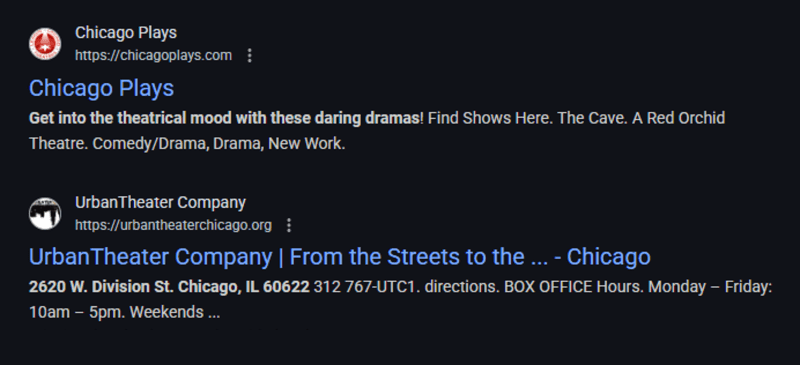One of the most common requests that I hear from clients is some variation of “I want to be found on Google.”
Google can be a powerful tool to route traffic to your website and, by extension, your business or organization. However, the most important quality of your website may not be how searchable it is.
In this article I’ll discuss conclusions drawn from reviewing the analytics of some of my clients’ websites. (I will present summary data only; the specific values and sources for these data will be kept confidential.)
I’m putting the key takeaways upfront, and the rest of the article will dig into the data that support these conclusions.
Without further ado, let’s get into it!
Table of Contents

A Note on SEO
If you have spent any amount of time looking for digital marketing advice, you’re bound to see a lot about SEO. Let’s talk a little about what it is.
SEO stands for “search engine optimization.” It’s a methodology that web marketers use to drive traffic to their sites. It’s also a buzzword and is touted as the best way to get thousands of visitors to your website.
When people talk about SEO, they usually mean one of two things:
1. Basic SEO
There are some essential SEO best practices that every website should be doing. These are things like including your address on your website and defining a title and description for every page in your website.
Squarespace offers this SEO checklist on how to improve your website’s searchability. I have also included an essentials list below.
While everything on these lists is good and useful to do, they will not normally cause exponential growth in your website traffic. But the data from my client websites show that basic SEO practices do contribute to steady linear growth in your website traffic.
2. Keyword Ranking
Keyword ranking means that when someone searches for a particular term, or keyword, your website appears at the top of the search results. This is usually what SEO experts are selling.
Basic SEO can be accomplished by anyone with intermediate technology skills. Keyword ranking takes months, writing a ton of high quality content, developing numerous links back to your site, and quite probably hiring an SEO expert.
Keyword ranking is quite difficult, especially when your industry has a lot of competition. Whether or not it’s worthwhile for your organization depends on your strategy of reaching new customers, members, or donors.
Eyes already glazing over? Get in touch to get a personalized recommendation for your website.
Google’s Impact: Key Takeaways
Based on the analytics data from my clients’ sites, here are the broad stroke conclusions I have drawn about getting found on Google:
Local businesses and organizations tend to get found by folks searching their local area on Google Maps and Google Search. This is most relevant to organizations that have a physical location but may apply to organizations that offer services in a specific area.
Universally appealing goods and services can get found via social media by sharing engaging photos and relatable stories. Baked goods, floral design, fence construction, tax assistance—these things are relevant to a the average person, and that makes them useful to share on social media.
Non-local organizations tend to get found primarily by direct traffic and navigational search. Take Fishers of Folk Digital Design, for example. I do not expect fishersoffolk.com to show up in search results when someone searches for “website designer” or even “small business website” because of the sheer number of relevant search results. But I do expect fishersoffolk.com to show up at the very top when someone searches for “fishers of folk websites”.
The impression given by your website is more important than how someone got there. Some folks might first learn of your organization by making a Google search and clicking your website in the results. Others might learn of your organization first, and then visit your website to evaluate the quality of your brand. In either case, it is critical that your website makes an exceptional first impression.
How Folks Are Finding Your Website
I analyzed website traffic sources for my previous clients, looking specifically at how people are getting to their websites. These are the summary data from this analysis and an interpretation of what they mean.
50-90% of traffic is direct.
This means someone typed myorganization.com in their web browser or has the site bookmarked. These site visits can come from existing customers and others who already have a relationship with your business. However, they can also come from prospective customers who have typed in your web address from a business card or flier, followed a link from an email you sent them, or arrived at your site from other source that’s difficult to track.
80% of traffic is unique.
This number holds true across the board for nearly all of my clients. It means that regardless of how people are getting to your site, only about 20% are returning visitors. Your own views may be part of this 20% unless your site analytics are set up to ignore your own traffic (Squarespace counts your own views unless you are logged in).
The exceptions to this stat are the client websites that receive a significant percentage of traffic from social media: their unique traffic is closer to 95%. This increase suggests that social media can help you reach a broader audience than you might otherwise achieve.
5% of traffic is from social media…except when it’s 20%.
For most of my clients, clicks from their posts or organization pages on social media account for only about 5% of their website traffic. The clients who are actively promoting their organizations on social media platforms see a much higher percentage (20%) of their traffic coming from social media.
45% of traffic is from search…except when it’s 5%.
My clients who 1) offer local goods and services, 2) frequently mention their location on their website, and 3) have had the same web address for over a decade all see about 45% of their website traffic coming from search.
My remaining clients receive 5-10% of their traffic from search. For them, the bulk of their website views comes from direct traffic to their site.
Websites that have been around for many years often perform better in search results due to several factors. They tend to have more content, more links built between related sites, and high domain authority scores. Even with these starting advantages, I have observed increases in site traffic after completing a redesign and adding basic SEO.
Frequently mentioning the location of your organization and services helps with local SEO rankings because it gives geographical context to your site information. Reviews and other factors included in this article from MailChimp contribute to your local SEO.
90% of all search traffic is from Google.
Whether your website receives 45% or 5% of its total traffic from search, Google is hands down the most impactful search engine for getting folks to your website. Google brings in 90% of all of my clients’ search traffic.

How to Get Found on Google
Without an aggressive SEO strategy, you are unlikely to rank in search for generic keywords. However, your website should come up in the top of the search results for search terms that are similar to your business name and services or location.
Here’s how your brand can get found more easily on Google by applying Basic SEO practices.
Use your keywords & location.
Research the terms your target audience uses to search for the goods and services your organization offers, and ensure those words are used on the pages of your website, especially page titles and headings. If you provide local services, be sure to mention that location on your site.
Set SEO descriptions.
“SEO descriptions” are the page titles and summaries that show up in search results. The default behavior is usually to show your site name followed by the page title, which may not grab someone’s attention. Set a custom SEO description for each of your pages to describe the value someone would receive by clicking it.

Set up a Google Business Profile.
Google provides a user-friendly guide on how to list your business on Google (it works for both regular search and maps). This is a free service offered by Google.
If your organization is listed on Google already, you may need to claim the Business Profile so you can manage it yourself. Read how to claim your Business Profile.
Get listed on relevant review sites.
If Yelp or another review service is relevant to your organization, set up a profile there in addition to setting up a Google business profile.
Ask for reviews.
Once you have your profile set up on Google and other services, ask folks to write reviews for you. Oftentimes they will.
Ask others to link to your site.
As you network, look for opportunities to suggest that someone links to relevant content on your website. This might be through affiliate organizations or bloggers and news services who cover the same topics as your organization.
Be patient.
Everything listed above takes time to build up. SEO is a long term investment, and the rules are changing as Google adopts AI summaries and other strategies to keep readers on the search page instead of clicking any of the results.
Which brings us to the next point…

Understand the Core Power of Your Website
Whatever strategy you have to grow your audience, your website is a powerful tool to support it. With or without ranking for keywords and getting found passively on Google search.
A well-made website gives your brand legitimacy. It allows you to tell your brand’s story and communicate what it means to interact with you. It offers an avenue to connect with your audience on both an informational and emotional level.
What do you offer that no one else does? Why can you be trusted? Your website answers this and more.
If a website looks good and is easy to navigate, that adds to a positive customer experience. But if a website looks outdated and has a dozen buried links, that signals you don’t care enough about your customers to give them an enjoyable digital experience.
Do you want your customers, members, or donors to think you don’t care about them?
It might be time for a website refresh. Get in touch to chat through options based on your unique needs.


